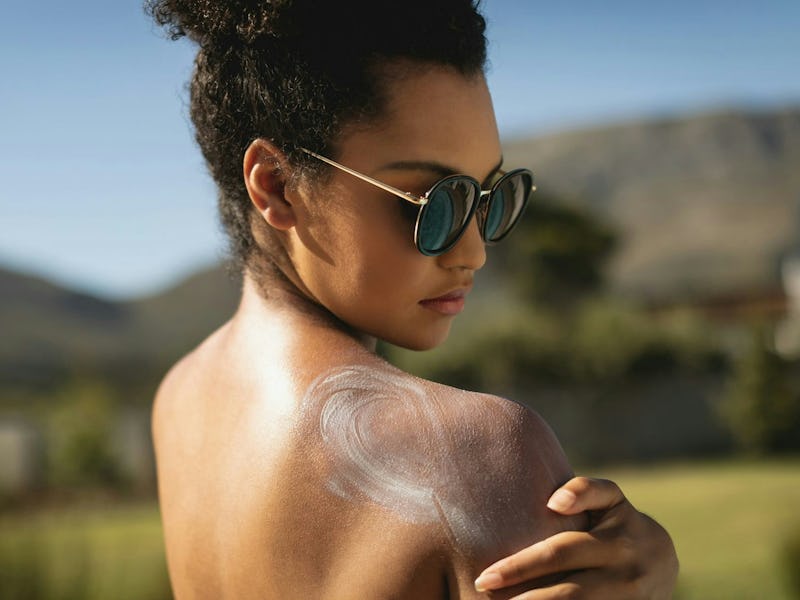The Truth About Suncreen And Vitamin D Production
Don’t listen to the hype — put on that sunscreen.

It’s all kicking off on social media again. This time it’s about wearing sunscreen. The argument began when Tim Spector, a professor of genetic epidemiology at King’s College London, raised concerns that daily sunscreen use could lead to vitamin D deficiency.
While Spector’s post gained a lot of attention, it isn’t the first time an argument against using sunscreen has been brought to social media – with countless posts discussing the matter. Most of these concerns stem from the fact that sunscreen blocks ultraviolet (UV) radiation – which our body needs to synthesize vitamin D in the skin. Fortunately, research shows us that this is probably not an issue for most people.
Vitamin D is an essential nutrient. It helps regulate calcium absorption, which is important for bone health. A growing body of research also suggests vitamin D may be important for other aspects of health, too, including boosting immunity, reducing inflammation and keeping the heart healthy. However, more research is needed to confirm these findings.
While we can get vitamin D from certain foods – such as oily fish, egg yolks, and fortified dairy products – our bodies mainly rely on sunlight to produce it in our skin.
When we’re exposed to the sun’s ultraviolet B radiation (UVB), a series of processes in our skin cells transform a cholesterol-like molecule into vitamin D3.
Since vitamin D production requires exposure to UVB radiation, it could be expected that sunscreen use inhibits vitamin D synthesis.
Sunscreen acts as a filter, absorbing or reflecting solar UV radiation. The higher a product’s sun protection factor (SPF), the better it is at preventing sunburn (which is mainly caused by UVB radiation). By preventing this radiation from reaching and mutating DNA in skin cells, sunscreens can lower skin cancer risk. Sunscreens have also been shown to reduce UV-radiation-induced skin aging.
However, sunscreens are not 100% effective – mainly because most people don’t use them as directed. People typically only apply around one-quarter to one-third of the required amount of sunscreen – and most don’t reapply as instructed. This means some UVB is still able to reach the skin’s surface.
Sunscreen and vitamin D
Many studies have investigated the effect of sunscreen use on vitamin D levels. Overall, findings indicate that with typical use, sunscreen still allows sufficient vitamin D production to happen.
In a study conducted by our research team, we performed a one-week experiment on 40 holidaymakers in Tenerife, Spain. Participants were taught to correctly apply an SPF 15 sunscreen to protect their skin.
Not only did the sunscreen protect participants from sunburn, their vitamin D levels improved. This showed us that even when sunscreen was used, a sufficient amount of UVB radiation still reached the skin, allowing vitamin D to be produced.
These findings align with two reviews that also examined real-world sunscreen use and vitamin D levels.
Most of the studies included in these reviews either reported that sunscreen use had no effect on vitamin D levels or that sunscreen use led to higher vitamin D levels. This was particularly true with field studies, which would have provided the best reflection of real-world sunscreen use and sun exposure.
However, these reviews also found several experimental studies (with more controlled conditions) that showed sunscreen use can prevent vitamin D synthesis. However, these studies used UV sources that were not representative of solar UV radiation, which may limit their relevance for real-world conclusions
Another limitation of the studies evaluated in these reviews was that most used low SPF sunscreens (around SPF 15 or lower). Public health advice recommends the use of at least SPF 30 sunscreen, which potentially could have a greater inhibitory effect on vitamin D production.
And most of these studies only used white participants. White skin has less melanin pigment, which acts as a natural sunscreen – protecting against UV damage (including sunburn).
Melanin may also have a potentially small, inhibitory effect on vitamin D production. Observational studies have consistently shown that people with dark skin tend to have poorer vitamin D levels than people with lighter skin tones living at similar latitudes. This disparity becomes even more pronounced at higher latitudes, where levels of UVB radiation are lower.
One review also found that people with lighter skin types produced more vitamin D. However, this discrepancy is probably due to differences in the way the studies included in the review were conducted. Some used artificial radiation sources, which do not represent solar UV radiation and may give unrepresentative results.
There’s a clear need to conduct more studies that include people with darker skin tones and use higher SPF sunscreens. However, based on the evidence we have available, typical sunscreen use does not inhibit vitamin D production. It also has the added benefit of preventing the damaging effects of UV exposure.
Given people with darker skin tones are at greater risk of having low vitamin D levels, spending more time in the sun may be of benefit. But while people with dark skin have a 20-60 times lower skin cancer risk than people with lighter skin, it’s still important to avoid the sun when it’s at its most powerful and wear sunscreen or cover-up if you are outside on sunny days.
This article was originally published on The Conversation by Karl Lawrence and Antony Young at King's College London. Read the original article here.